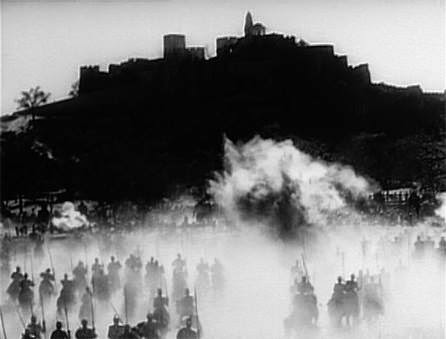This Wednesday, as part of Hibbleton Gallery’s ongoing Introdution to the Cinema of India, award-winning filmmaker Steve Elkins will give a presentation on films of the silent and early sound era, including the films of D. G. Phalke who, trained as a magician by one of the 40 employed by the Lumiere Brothers, gave birth to Indian cinema with the first timelapse film ever made. He soon made India's first feature film ("Raja Harishchandra," 1912), about the release of the divine feminine creative power (trishakti) which Hindus believe is the primordial cosmic energy responsible for creation and the agent of all change. We will also watch "Lanka Aflame" (1917), in which the monkey god Hanuman sets fire to the city of Lanka with his tail), and “Kaliya Mardan” (1919), in which Krishna jumps off the branch of a tree to have an underwater battle with the snake Kaliya before assuming the weight of the entire universe and dancing the beat of time onto his head (an episode from the Mahabharata).
 |
| Scene from D.G. Phalke's film "Kaliya Mardan" (1919 |
The events depicted in Kaliya Mardan have been celebrated as a major festival at the Tulsi Ghat in Varanasi since the 16th century. Thousands gather to watch a large branch of Kadamba tree planted at the edge of the river Ganga and a young boy acting as Krishna - who functions in this context not as a mere actor, but as the embodied form (svarup) of Krishna - jump from the tree branch into the river, where an effigy of Kaliya lies in wait. The child embodying Krishna climbs onto the effigy's head and strikes a flute playing pose. Propelled by human assistants, the serpent effigy along with the boy Krishna on its head make a circular sweep in the water, parading in front of thousands of spectators, who watch the display from the river bank or from boats floating on the Ganges waters. The festival is viewed from a royal boat every year by Kashi Naresh (the titular king of Varanasi), who is even today believed to be an incarnation of Shiva.
 |
| Annual Festival at Tulsi Ghat |
We’ll also watch Vishnupant Damle and Sheikh Fattelal's 1936 film "Sant Tukaram," about the 17th century Maharashtra bhakti yoga saint, whose poetry articulates some of the challenges posed by the Bhakti movement against caste hierarchies and ritual / scripture based conceptions of Brahmanic religion. It features one of the great scenes in cinema history, when Tukaram is carried off to heaven on the bird-chariot Garuda, the vehicle of Vishnu!!!
 |
| Scene from "Sant Tukuram" (1936) |
We will also watch excerpts of three films by V. Shantaram. "Maya Machchindra" (1932), based on a tantric legend and set in the remote world of Nath yogis (the sect of which Shiva himself was the first yogi), examines the Hindu concept that the world is "maya" (roughly "web of illusion"). "Churning The Ocean Of Nectar" (1934) questions the validity of animal and human sacrifices in religion. Finally, "Padosi" (1941) explores Hindu-Muslim unity in pre-independence India through the relationship of chess partners in a village. This image is from Shantaram's "Two Eyes, Twelve Hands" (1957), about the 'open-prison' experiment of Swatantrapur, in which a Jain jail warden tests criminal reform without incarceration, in the spirit of Gandhian ideology.
 |
| Scene from "Two Eyes, Twelve Hands" (1957) |
Additionally, we'll explore the work of the great Muslim director Mehboob Khan (1906 - 64), perhaps best known for the national epic "Mother India" (1957). Given Islamic restrictions on the depiction of God and his Prophets, there is no equivalent “Islamic” film to parallel the mythological and devotional films of Hinduism, but there are "Islamicate" films concerned with religion as part of everyday social and cultural life among Muslims, rather than religious belief per se. We will watch excerpts of Mehboob's "Humayun" (1945) a historical epic about the Mughal empire in India (an era in which Muslims spread religious tolerance and egalitarian principles toward all religions and ethnic groups) featuring stunning and massive elephant battles. We will discuss how Mehboob filters history through cinema to influence Hindu-Muslim relations in the last year's before India's independence.
 |
| From the work of Mehboob Khan |
Finally, we'll tie these films to contemporary history with Anand Patwardhan's documentary "RAM KE NAAM" (IN THE NAME OF GOD, 1991), about the deadly riots that erupted across India after thousands of Hindu fundamentalists made the 1990 "rath yatra" (chariot journey) from Somnath in Gujarat to destroy the Babri mosque in Ayodhya, which is believed to be built over the sacred birthplace of the Hindu God Lord Ram. The film is the second part of a trilogy of documentaries by India's most notorious social justice documentarian, Anand Patwardhan, examining the integration of Hindu, Sikh, and Muslim fundamentalism into India's political parties. In this photo, Muslims pray in the ruins of the mosque the fundamentalists destroyed.
 |
| Anand Patwardhan's documentary "RAM KE NAAM" (IN THE NAME OF GOD, 1991) |
Patwardhan, whose films are often shot in secret and cut into segments to be smuggled abroad and reassembled outside the country, explores a common theme of early Indian cinema: can India set an example to the world by rooting national identity in communal harmony between Hindus and Muslims no matter how much vulnerability this entails? Does denigrating another person’s religion degrade one's own? Part of a trilogy of documentaries examining the integration of religious fundamentalism into India's political parties, and whether the psychology of violence against “the other” may lie in male insecurity, (itself an inevitable product of the very construction of “manhood").
This amazing night of films and discussion is FREE and starts at 7:30 at Hibbleton Gallery. Hope to see you there!
(The descriptions of films in this post were written by Steve Elkins.)
(The descriptions of films in this post were written by Steve Elkins.)
